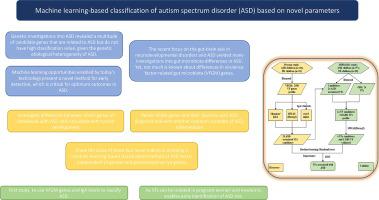当前位置:
X-MOL 学术
›
Comput. Struct. Biotechnol. J.
›
论文详情
Our official English website, www.x-mol.net, welcomes your
feedback! (Note: you will need to create a separate account there.)
Virulence factor-related gut microbiota genes and immunoglobulin A levels as novel markers for machine learning-based classification of autism spectrum disorder
Computational and Structural Biotechnology Journal ( IF 4.4 ) Pub Date : 2020-12-29 , DOI: 10.1016/j.csbj.2020.12.012 Mingbang Wang , Ceymi Doenyas , Jing Wan , Shujuan Zeng , Chunquan Cai , Jiaxiu Zhou , Yanqing Liu , Zhaoqing Yin , Wenhao Zhou
Computational and Structural Biotechnology Journal ( IF 4.4 ) Pub Date : 2020-12-29 , DOI: 10.1016/j.csbj.2020.12.012 Mingbang Wang , Ceymi Doenyas , Jing Wan , Shujuan Zeng , Chunquan Cai , Jiaxiu Zhou , Yanqing Liu , Zhaoqing Yin , Wenhao Zhou

|
Autism spectrum disorder (ASD) is a neurodevelopmental condition for which early identification and intervention is crucial for optimum prognosis. Our previous work showed gut Immunoglobulin A (IgA) to be significantly elevated in the gut lumen of children with ASD compared to typically developing (TD) children. Gut microbiota variations have been reported in ASD, yet not much is known about virulence factor-related gut microbiota (VFGM) genes. Upon determining the VFGM genes distinguishing ASD from TD, this study is the first to utilize VFGM genes and IgA levels for a machine learning-based classification of ASD. Sequence comparisons were performed of metagenome datasets from children with ASD ( = 43) and TD children ( = 31) against genes in the virulence factor database. VFGM gene composition was associated with ASD phenotype. VFGM gene diversity was higher in children with ASD and positively correlated with IgA content. As Group B streptococcus (GBS) genes account for the highest proportion of 24 different VFGMs between ASD and TD and positively correlate with gut IgA, GBS genes were used in combination with IgA and VFGMs diversity to distinguish ASD from TD. Given that VFGM diversity, increases in IgA, and ASD-enriched VFGM genes were independent of sex and gastrointestinal symptoms, a classification method utilizing them will not pertain only to a specific subgroup of ASD. By introducing the classification value of VFGM genes and considering that VFs can be isolated in pregnant women and newborns, these findings provide a novel machine learning-based early risk identification method for ASD.
中文翻译:

毒力因子相关肠道微生物群基因和免疫球蛋白 A 水平作为基于机器学习的自闭症谱系障碍分类的新标记
自闭症谱系障碍 (ASD) 是一种神经发育疾病,早期识别和干预对于获得最佳预后至关重要。我们之前的研究表明,与正常发育 (TD) 儿童相比,自闭症谱系障碍 (ASD) 儿童肠腔内的肠道免疫球蛋白 A (IgA) 显着升高。自闭症谱系障碍(ASD)中已有肠道微生物群变异的报道,但人们对毒力因子相关肠道微生物群(VFGM)基因知之甚少。在确定区分 ASD 和 TD 的 VFGM 基因后,本研究首次利用 VFGM 基因和 IgA 水平对 ASD 进行基于机器学习的分类。将 ASD 儿童 (= 43) 和 TD 儿童 (= 31) 的宏基因组数据集与毒力因子数据库中的基因进行序列比较。 VFGM 基因组成与 ASD 表型相关。自闭症儿童中 VFGM 基因多样性较高,且与 IgA 含量呈正相关。由于 B 族链球菌 (GBS) 基因在 ASD 和 TD 之间的 24 种不同 VFGM 中所占比例最高,并且与肠道 IgA 呈正相关,因此将 GBS 基因与 IgA 和 VFGM 多样性结合起来以区分 ASD 和 TD。鉴于 VFGM 多样性、IgA 增加和富含 ASD 的 VFGM 基因与性别和胃肠道症状无关,利用它们的分类方法将不仅仅适用于 ASD 的特定亚组。通过引入VFGM基因的分类价值,并考虑到VF可以在孕妇和新生儿中分离出来,这些发现为ASD提供了一种新的基于机器学习的早期风险识别方法。
更新日期:2020-12-29
中文翻译:

毒力因子相关肠道微生物群基因和免疫球蛋白 A 水平作为基于机器学习的自闭症谱系障碍分类的新标记
自闭症谱系障碍 (ASD) 是一种神经发育疾病,早期识别和干预对于获得最佳预后至关重要。我们之前的研究表明,与正常发育 (TD) 儿童相比,自闭症谱系障碍 (ASD) 儿童肠腔内的肠道免疫球蛋白 A (IgA) 显着升高。自闭症谱系障碍(ASD)中已有肠道微生物群变异的报道,但人们对毒力因子相关肠道微生物群(VFGM)基因知之甚少。在确定区分 ASD 和 TD 的 VFGM 基因后,本研究首次利用 VFGM 基因和 IgA 水平对 ASD 进行基于机器学习的分类。将 ASD 儿童 (= 43) 和 TD 儿童 (= 31) 的宏基因组数据集与毒力因子数据库中的基因进行序列比较。 VFGM 基因组成与 ASD 表型相关。自闭症儿童中 VFGM 基因多样性较高,且与 IgA 含量呈正相关。由于 B 族链球菌 (GBS) 基因在 ASD 和 TD 之间的 24 种不同 VFGM 中所占比例最高,并且与肠道 IgA 呈正相关,因此将 GBS 基因与 IgA 和 VFGM 多样性结合起来以区分 ASD 和 TD。鉴于 VFGM 多样性、IgA 增加和富含 ASD 的 VFGM 基因与性别和胃肠道症状无关,利用它们的分类方法将不仅仅适用于 ASD 的特定亚组。通过引入VFGM基因的分类价值,并考虑到VF可以在孕妇和新生儿中分离出来,这些发现为ASD提供了一种新的基于机器学习的早期风险识别方法。









































 京公网安备 11010802027423号
京公网安备 11010802027423号